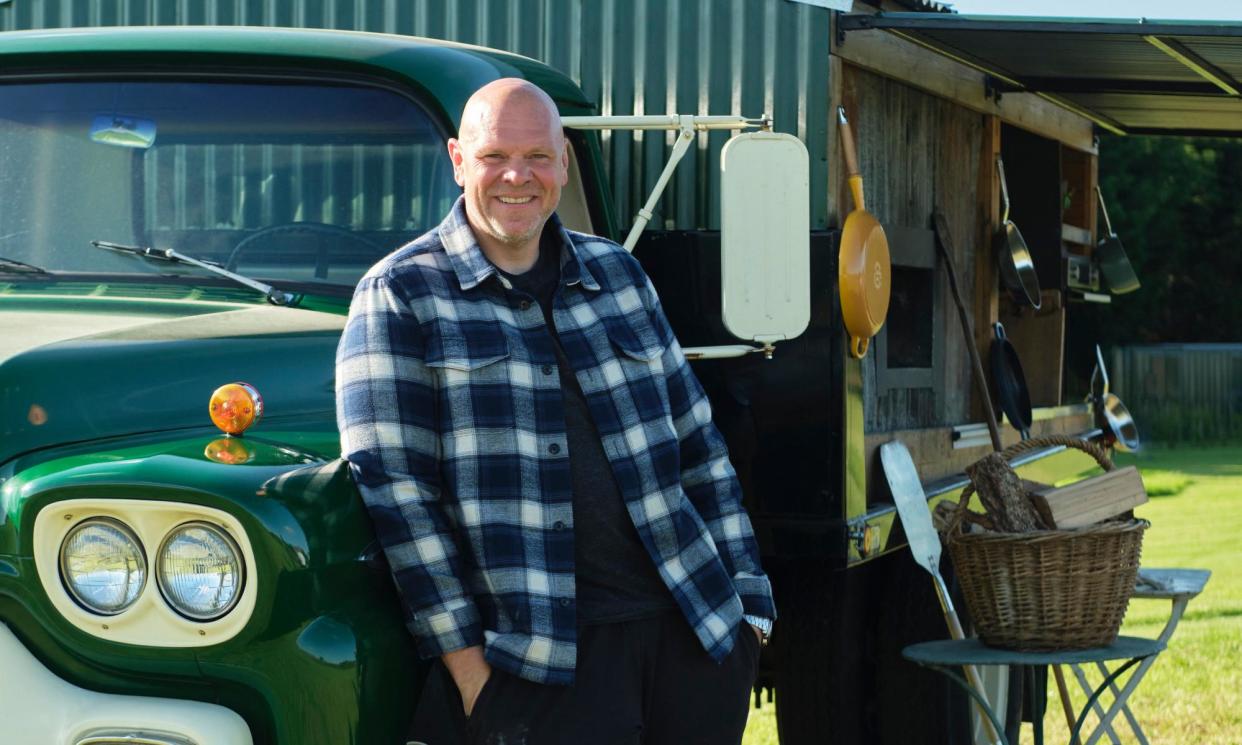Tom Kerridge Cooks Britain review – an empty, flavourless screensaver passing for television

There is nothing inherently wrong with Tom Kerridge Cooks Britain (ITV1), it is just that there is not particularly anything to it, either. Over half an hour, there are more mentions of the supermarket chain sponsoring the show than there are recipes for the ingredients it highlights (the dishes look delicious, but there are only two of them). Kerridge has been fronting ads for this chain, which pushes a “meet the farmers” campaign, for a while now. This six-part series is simply an extended version of those adverts, repackaged as a television series, in which we get to see some of the pickers, too. It is perfectly pleasant, if flavourless.
Kerridge is an institution of the British culinary scene, and his gastropub The Hand and Flowers, in Marlow, became the first pub to receive two Michelin stars. He has long been a familiar face on television, and for many years he has put his high profile to good use, campaigning for more government support for hospitality, organising against child food poverty, and providing thousands of meals for key workers during the pandemic. Here, we see him with another hat on: fronting a programme that removes the politics from food production almost entirely.
This is understandable, as it is clearly a form of #sponcon. This is not just a food documentary, this is an M&S food documentary etc. But the absence of substance is certainly noticeable. Tom Kerridge Cooks Britain promises to ask the question, “What does it take to put food on your plate?”, which is enormously important, now more than ever. Yet food security has been a curiously underplayed concern in this election cycle. The National Farmers Union has gone so far as to call it a “worrying blind spot” for the main political parties, and by the end of August we will see what months of relentlessly wet weather have done to key crops such as wheat and barley.
Kerridge drives his rickety green food truck down country lanes, wishing it had modern suspension
There is no talk of climate here, no talk of economics, no talk of the labour force that British farms depend on, other than a little nod to the pickers at the very end of the episode, when Kerridge hails technological advances in farming but notes that it is “still driven by hard-working people and those are the real superheroes of the food world”. Instead, what we see is a bucolic, pastoral vision of England’s agricultural regions. In this opening episode, Kerridge drives his rickety green food truck down country lanes, wishing it had modern suspension. He visits the Fens, and later Kent, also known as the garden of England because it is where most of Britain’s fruit is grown.
In the Fens, Kerridge drops in on a farm producing 3.1m bunches of beetroot annually, part of an overall output of 300m packets of veg. We see the pickers out in the field, harvesting by hand. Then it all goes a bit Inside the Factory, as the pickers are followed by a substantial processing rig, in which the beetroot is sorted, weighed by eye, trimmed and put into crates, which might arrive on supermarket shelves that same day. It is an impressive operation. Similarly, we get to see the devices used to test the precise moment that an apple is perfectly crunchy and perfectly sweet, on a fruit farm in Kent.
Kerridge is likable and self-aware enough to be mildly apologetic about anything he considers too cheffy, even noting that it is one thing for restaurants to use fresh local veg, pulled straight from the ground, and quite another to make that work on a scale needed to feed a nation. And there is one outstanding tip for crumble-lovers, which is to put half of your crumble mix on top of the stewed/stewing fruit, and do half on a separate tray, to sprinkle over the top at the end, preserving some of the crunch. I will be using it.
Every few years, another study comes out that reveals how little children know about where their food comes from. Often it leads to amusing headlines, such as kids thinking that fish fingers come from chicken, or that strawberries come from the fridge. But they also highlight a bigger problem, which is that as a people, younger or older, we are increasingly disconnected from having to think about how strange it is, for example, that we can eat strawberries in December, or that milk could ever be sold cheaply, considering what goes into its production. This is not going to address those questions, and it seems unfair to criticise it for not being an entirely different programme. It is not unpleasant or contentious viewing. It is just an airy, gentle, screensaver of a television show that doesn’t say a great deal.

 Yahoo News
Yahoo News 
